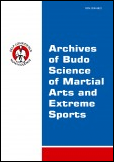2019, Volume 15, Issue 1
Injuries and somatic build of athletes practising competitive judo
Kazimierz Witkowski1, Jarosław Maśliński1, Paweł Piepiora1, Robert Radlak1, Jacek Stodółka1
1University School of Physical Education in Wrocław, Wrocław, Poland
Author for correspondence: Paweł Piepiora; University School of Physical Education in Wrocław, Wrocław, Poland; email: pawel.piepiora@awf.wroc.pl
Full text
Abstract
Background and Study Aim: Combat sports are characterised by a high dynamics of activities. One of the unwanted elements of the training process are injuries. The aim of this study was the knowledge about the body type of persons practising judo in accordance with Wanke’s typology and to specify injuries that are characteristic of individual body types of athletes.
Material and Methods: The study was conducted on a group of men being members of the Junior Polish National Team. They included 29 athletes aged 17-19 years, representing various weight categories at judo competitions. The minimum experience of the subjects was 5 years. Another qualifying criterion was a medal at the Polish Junior, Youth or Senior Championships. Anthropometric measurements were carried out for the purpose of determining the somatic build. In the course of research a typical set of anthropometric instruments was used and Martin’s measuring technique was applied. The athletes examined were classified into particular somatic types using Wanke’s typology.
Results: Judo athletes in the 90-100 kg category were characterised by high values of pelvic width and chest depth. Athletes in the 81-90 kg category were characterised by wide shoulders. In the group examined there was a high percentage of knee, finger and toe injuries.
Conclusions: With regard to somatotypes a general tendency was observed, consisting in the body type becoming stronger, as the weight categories go up, i.e. an increase in the “H” component and a definite decrease in the “I” component. The most frequent injuries suffered by the athletes examined were injuries of the knee, spine, fingers and toes, regardless of their body type. It may be concluded that it is the nature of sport combat that generates the prevalence of given injuries in judo.
Key words: Martin’s measuring technique, anthropometric, performance, Wanke’s typology, weight category





